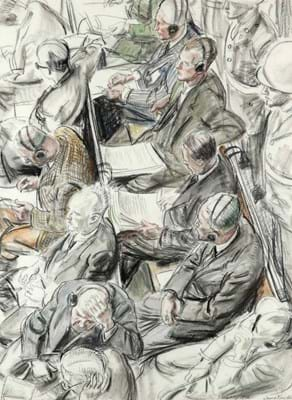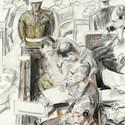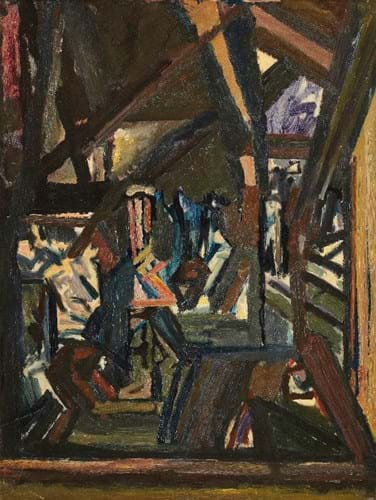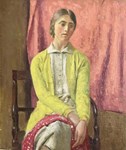She spent three months observing the events from inside Courtroom 600 and gained special access to the broadcasting box just above the prisoners, where she was able to make studies of the protagonists among the lawyers and the accused.
The finished oil, featuring 20 senior Nazis in a courtroom against the backdrop of a ruined city, is on display at the Imperial War Museum.
The picture sale at Woolley & Wallis (25% buyer’s premium) in Salisbury on December 7 included two of Knight’s sketches for the painting. Each measuring 2ft 6in x 22in (76 x 56cm), they were worked in charcoal, coloured chalks and watercolour.
They had remained with the artist until 1963 when they entered a private collection; both will now be included in John Croft’s catalogue raisonné.
Because of the subject matter these are important works, offering in colour an eye-witness account of an event now remembered only in grainy black and white film.
Seated in the image titled Prisoners in the Dock at the Nuremberg Trial No.1 are Hermann Göring, Rudolf Hess, Joachim von Ribbentrop and Wilhelm Keitel with Karl Dönitz in the row behind.
Depicted in the other titled Prisoners in the Dock at the Nuremberg Trial No.2 are Alfred Rosenberg, Hans Frank, Wilhelm Frick, Julius Streicher, Walther Funk, Hjalmar Schacht, Franz von Papen, Arthur Seyss-Inquart, Albert Speer, Konstantin von Neurath and Hans Fritzsche.
Determining a commercial value for the two sketches was difficult but, at a time when art relating to the First and Second World Wars is avidly collected, they appeared reasonable at £3000-5000 each. In fact, after spirited bidding they took £12,000 and £10,000 respectively.
Bomberg at the bomb store
Works by David Bomberg (1890-1957) appear regularly at auction and tend to perform consistently well, thanks to a strong following of both dealers and collectors.
If there is any pattern to the market, his Spanish scenes, views of Jerusalem and early 1920s figurative works appear to be the most popular and the largest and most striking can easily make six-figure sums.
So, how would a later British subject get on at auction?
One appeared at West Norwood, London, saleroom Roseberys (25% buyer’s premium) on October 13.
The Bomb Store from 1942 was part of a small group of near-abstract works produced after he was commissioned by the War Artists Advisory Committee to paint an underground bomb store at RAF Fauld in Tutbury.
Two of the works are now in the collection of Tate Britain and related sketches can be found in the Imperial War Museum.
Another appeared at Sotheby’s in June, selling at £50,000.
The work at Rosebery’s, a 2ft 6in x 22½in (76 x 57cm) oil on paper laid down on board, was estimated at £20,000-30,000.
It drew decent bidding before it was knocked down at £40,000 to a London-based private buyer on the phone – a fair price considering the Sotheby’s work was an oil on canvas.
While these sums might not be in the upper league for Bomberg, they underlined the lively activity that exists at different levels of the market, not just at the very top end.




















